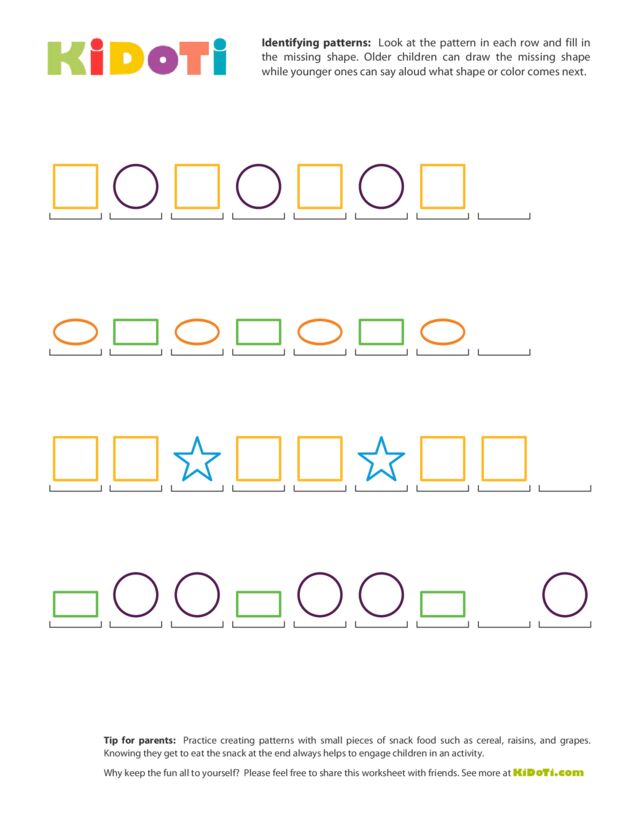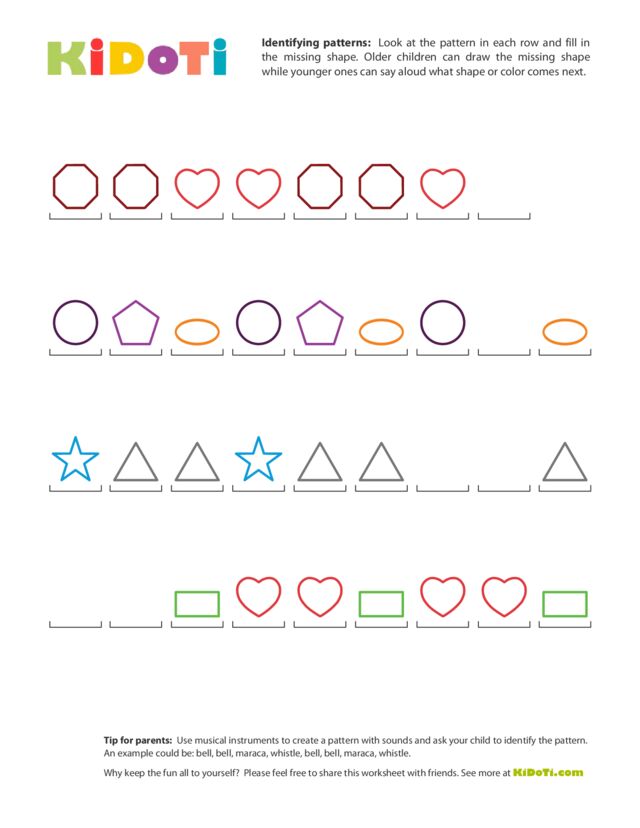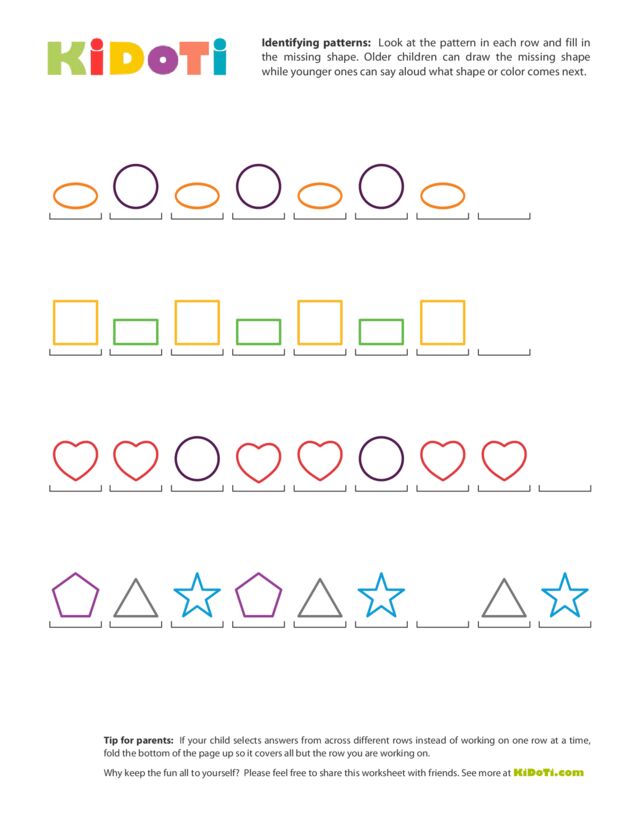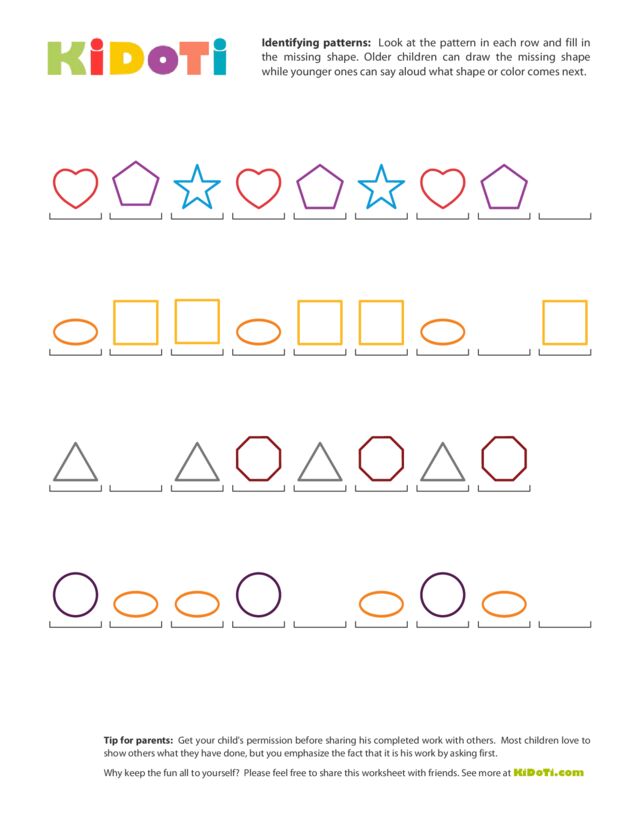Identifying patterns is a basic skill taught in preschool and kindergarten. Patterns are a recurring theme in preschool and kindergarten math lessons because patterns occur naturally when counting. The most basic pattern is the AB pattern, where two items repeat in an alternating pattern at least two times without interruption, although kindergarten students eventually learn more advanced kindergarten patterns such as ABC, AABB, ABB and others.
More about the importance of pattern activities
Understanding patterns is an important mathematical concept that serves as a foundation for other math skills. Counting, for instance, is much easier when a pattern is recognized. For example, when counting by 10, each number ends in a zero.
In addition, understanding patterns helps children make predictions and feel comfortable in their environment as they notice patterns of behavior.
Extra tips for using pattern worksheets
Pattern worksheets are a fun and easy way to introduce children to the importance of patterning. The easiest pattern for children to learn is the AB pattern, where two items alternate ABAB to create a pattern.
The beginning patterning worksheets ask your child to identify this basic AB pattern and complete the pattern by filling in the missing boxes with shapes cut out at the bottom of the page. Since the goal of this worksheet is to practice identifying and completing patterns, consider cutting out the boxes so that they are cleanly cut and the picture is not distorted. To increase your child’s opportunity for success, place the seven cut squares on the table next to the worksheet and review the name of each shape with your child before he begins.
As your child reviews each row on the pattern worksheet, ask him to point to each box and name the shape as he moves across the row. (Naming the color would also work, if that is easier for your child.) When he comes to a blank box, ask him to continue naming the pattern to decide which shape belongs in that empty box to complete the pattern.
If your child is unsure about which shape fits in the empty box, help him narrow the choices to two by highlighting the two shapes used in that row on the worksheet. As he holds the two possible shapes, encourage him to say aloud the pattern again. With only two choices, the answer should be more obvious to your child.
The intermediate pattern worksheets increase in difficulty because the patterns are not only the AB pattern. Also, the missing shape must be drawn in the empty space instead of being picked from a small group of cut-out shapes. If your child is not yet able or comfortable drawing the shape, you may draw in the shape after your child dictates it to you. Or, you could encourage your child to just fill in the missing box with the color of the missing shape.
The advanced pattern worksheets introduce a sequence that is 5, 6, or 7 lines long. Name each line in the pattern with the terms “tall,” “medium,” and “short” and ask your child to point to each line in the row as he says aloud its name using the correct length term. Also, have your child count the number of lines that create the first sequence so that he knows how many lines he has to draw to create each pattern. The first repetition of each pattern is printed boldly, with the dashed lines indicating the start of the second repetition of the pattern. To create a pattern, your child will need to replicate the first series of 5, 6, or 7 lines at least one additional time (since a pattern is any series of things that repeats at least twice).
Pattern activities to try at home to supplement the pattern worksheets
- Practice creating patterns with small pieces of snack food such as cereal, raisins, and grapes. Knowing they get to eat the snack at the end always helps to engage children in an activity. Or, visit a craft store such as Michael’s or Jo Ann Fabric for colorful and inexpensive hands-on materials like puffs and beads which are great for creating patterns and completing pattern activities.
- Point out patterns when you see them in the environment. For example, the red and white alternating stripes on a flag. Or, the traffic light sequence of green light, yellow light, red light, green light, yellow light, red light.
- Create a pattern with hand movements, such as clap, clap, snap, touch your head, clap, clap, snap, touch your head. Repeat the pattern twice then have your child repeat it. Or, create a pattern when you are taking a walk with your child, such as “Step, step, hop, step, step, hop.” Say the pattern aloud as you move. You can also identify a pattern and say it aloud when you notice repetitive movements from your child. For example, when your child is playing with a ball, point out the “bounce, catch, bounce, catch” pattern.
- When eating dinner, eat your food in a specific order and challenge your child to identify the pattern. For example, carrot, carrot, noodle, tomato, carrot, carrot, noodle, tomato. Or, buy different flavored fish-shaped crackers or bear-shaped cookies and challenge your child to eat them in a specific pattern such as cheddar fish cracker, pretzel fish cracker, cheddar fish cracker, wheat fish cracker, cheddar fish cracker, pretzel fish cracker, cheddar fish cracker, wheat fish cracker.



